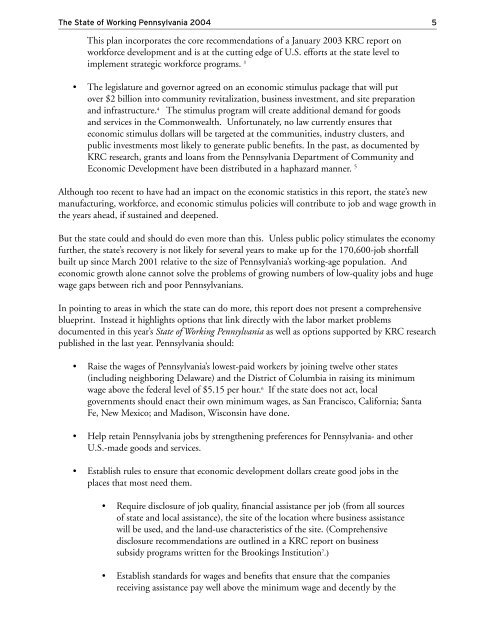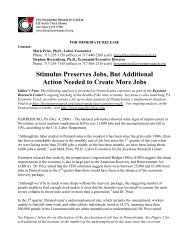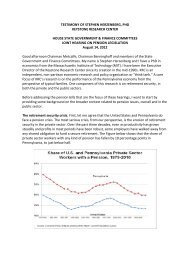The State of Working Pennsylvania 2004 - The Keystone Research ...
The State of Working Pennsylvania 2004 - The Keystone Research ...
The State of Working Pennsylvania 2004 - The Keystone Research ...
Create successful ePaper yourself
Turn your PDF publications into a flip-book with our unique Google optimized e-Paper software.
<strong>The</strong> <strong>State</strong> <strong>of</strong> <strong>Working</strong> <strong>Pennsylvania</strong> <strong>2004</strong> 5<br />
This plan incorporates the core recommendations <strong>of</strong> a January 2003 KRC report on<br />
workforce development and is at the cutting edge <strong>of</strong> U.S. efforts at the state level to<br />
implement strategic workforce programs. 3<br />
• <strong>The</strong> legislature and governor agreed on an economic stimulus package that will put<br />
over $2 billion into community revitalization, business investment, and site preparation<br />
and infrastructure. 4 <strong>The</strong> stimulus program will create additional demand for goods<br />
and services in the Commonwealth. Unfortunately, no law currently ensures that<br />
economic stimulus dollars will be targeted at the communities, industry clusters, and<br />
public investments most likely to generate public benefits. In the past, as documented by<br />
KRC research, grants and loans from the <strong>Pennsylvania</strong> Department <strong>of</strong> Community and<br />
Economic Development have been distributed in a haphazard manner. 5<br />
Although too recent to have had an impact on the economic statistics in this report, the state’s new<br />
manufacturing, workforce, and economic stimulus policies will contribute to job and wage growth in<br />
the years ahead, if sustained and deepened.<br />
But the state could and should do even more than this. Unless public policy stimulates the economy<br />
further, the state’s recovery is not likely for several years to make up for the 170,600-job shortfall<br />
built up since March 2001 relative to the size <strong>of</strong> <strong>Pennsylvania</strong>’s working-age population. And<br />
economic growth alone cannot solve the problems <strong>of</strong> growing numbers <strong>of</strong> low-quality jobs and huge<br />
wage gaps between rich and poor <strong>Pennsylvania</strong>ns.<br />
In pointing to areas in which the state can do more, this report does not present a comprehensive<br />
blueprint. Instead it highlights options that link directly with the labor market problems<br />
documented in this year’s <strong>State</strong> <strong>of</strong> <strong>Working</strong> <strong>Pennsylvania</strong> as well as options supported by KRC research<br />
published in the last year. <strong>Pennsylvania</strong> should:<br />
• Raise the wages <strong>of</strong> <strong>Pennsylvania</strong>’s lowest-paid workers by joining twelve other states<br />
(including neighboring Delaware) and the District <strong>of</strong> Columbia in raising its minimum<br />
wage above the federal level <strong>of</strong> $5.15 per hour. 6 If the state does not act, local<br />
governments should enact their own minimum wages, as San Francisco, California; Santa<br />
Fe, New Mexico; and Madison, Wisconsin have done.<br />
• Help retain <strong>Pennsylvania</strong> jobs by strengthening preferences for <strong>Pennsylvania</strong>- and other<br />
U.S.-made goods and services.<br />
• Establish rules to ensure that economic development dollars create good jobs in the<br />
places that most need them.<br />
• Require disclosure <strong>of</strong> job quality, financial assistance per job (from all sources<br />
<strong>of</strong> state and local assistance), the site <strong>of</strong> the location where business assistance<br />
will be used, and the land-use characteristics <strong>of</strong> the site. (Comprehensive<br />
disclosure recommendations are outlined in a KRC report on business<br />
subsidy programs written for the Brookings Institution 7 .)<br />
• Establish standards for wages and benefits that ensure that the companies<br />
receiving assistance pay well above the minimum wage and decently by the







